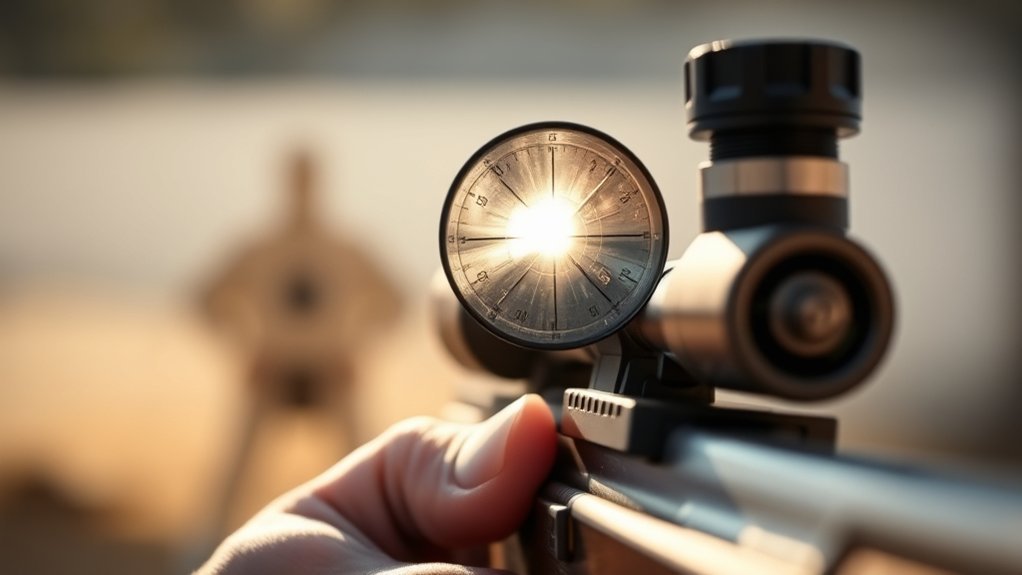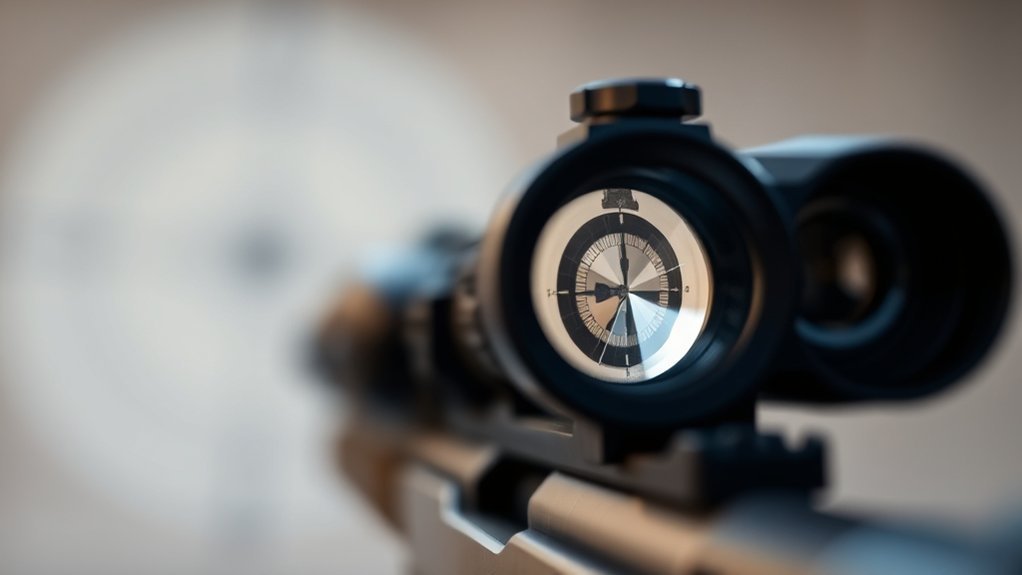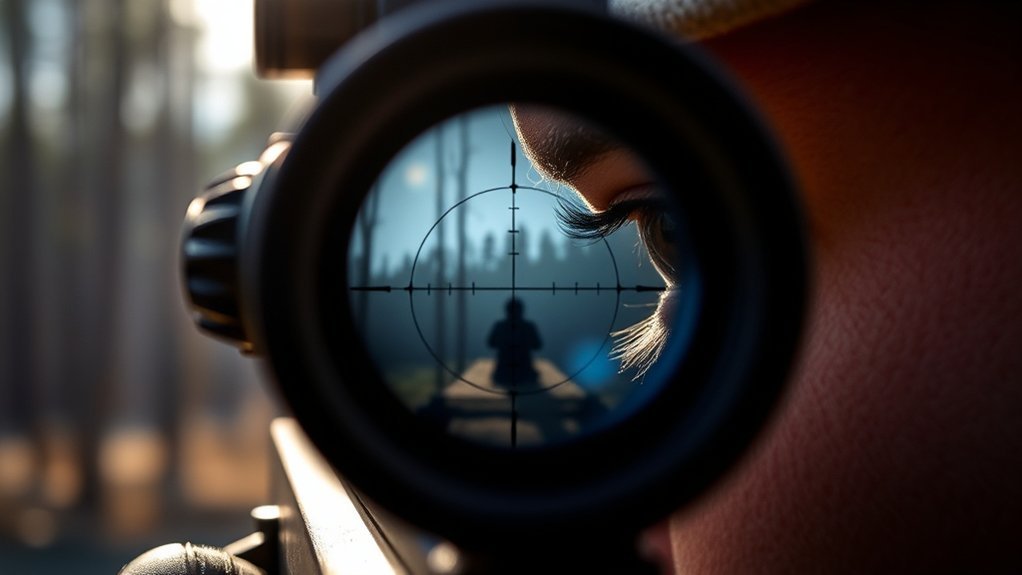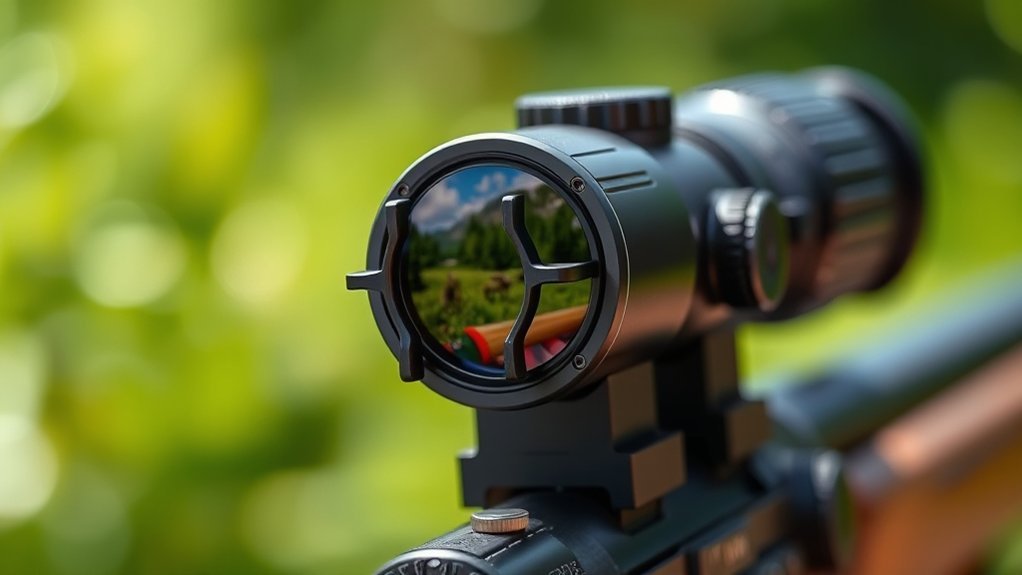When it comes to shooting, understanding sight alignment and sight picture is vital for improving your accuracy. Sight alignment guarantees your front and rear sights are properly positioned, while sight picture focuses on how these sights relate to your target. Mastering both can greatly enhance your shooting performance. But what common mistakes might be holding you back? And how can you refine these essential skills for better results? Let’s explore these concepts further.
Understanding Sight Alignment

Sight alignment is essential for accurate shooting, as it involves properly positioning the front and rear sights in relation to each other. To achieve this, you should focus on lining up the top of the front sight post with the notch of the rear sight. Verify that both sights are level and centered in your field of view. You’ll want to maintain a steady grip and proper stance to minimize movement. Remember, any misalignment can result in an inaccurate shot, so practice is key. Make sure you’re aware of how your sight picture changes with different shooting positions. By mastering sight alignment, you’ll lay the groundwork for achieving precision in your shooting efforts. Prioritize this technique to enhance your overall performance.
The Importance of Sight Picture

Understanding sight picture is essential for improving your shooting accuracy. It involves how you align your target with your sights, and various factors can influence this alignment. By mastering practical training techniques, you can enhance your overall performance on the range.
Definition of Sight Picture
A clear sight picture is essential for accurate shooting, as it allows you to align your firearm with the target effectively. It’s the mental image you create when you focus on your target, ensuring your sights are properly aligned. Here’s what a good sight picture includes:
- Front Sight: The sharp, clear image of the front sight, ideally centered in your view.
- Rear Sight: A blurred but recognizable outline of the rear sight, aiding alignment.
- Target: The target should be visible and properly framed between your sights.
- Background: An unobstructed background helps eliminate distractions and maintains focus.
Factors Affecting Accuracy
Achieving a proper sight picture directly influences your shooting accuracy. When you line up your sights, make sure the front sight is sharp and clear, while the target appears slightly blurred. This focus helps you maintain control over your shot. Environmental factors, like wind and lighting, can also impact your accuracy. Remember to account for these conditions as they can alter your perception of the target. Additionally, your stance and grip play critical roles; an unstable hold can lead to misalignment. Finally, mental focus is essential. Distractions can compromise your ability to maintain a consistent sight picture. By paying attention to these factors, you’ll improve your accuracy and become a more effective shooter.
Practical Training Techniques
Mastering the sight picture is essential for any shooter looking to enhance their skills. A proper sight picture allows you to align your sights with your target effectively, improving accuracy. Here are some practical training techniques to help you refine your sight picture:
- Dry Fire Practice: Use an unloaded firearm to practice aiming without recoil distractions.
- Focus Drills: Alternate focusing between your front sight and target to improve clarity.
- Target Acquisition: Set up various targets at different distances to challenge your adaptability.
- Group Shooting: Fire a series of shots at the same target to assess consistency and make necessary adjustments.
Incorporating these techniques into your routine will solidify your sight picture and elevate your shooting performance.
The Relationship Between Sight Alignment and Sight Picture

Understanding the relationship between sight alignment and sight picture is vital for accurate shooting. While sight alignment refers to the proper positioning of your sights, sight picture involves what you see when you look through them. Both elements work together to enhance your accuracy, making it essential to master each aspect.
Definitions and Differences
Sight alignment and sight picture are vital concepts in marksmanship, each playing a distinct role in achieving accurate shooting. Understanding their definitions and differences helps you develop your skills effectively.
- Sight Alignment: This refers to the proper positioning of your front and rear sights, ensuring they’re aligned with each other and the target.
- Sight Picture: This is the visual representation you see when your sights are aligned with the target, including the target itself.
- Focus: In sight alignment, your focus is on the sights; in sight picture, it shifts to the target.
- Execution: Achieving sight alignment is the first step, while sight picture is vital for the final aiming process before you pull the trigger.
Recognizing these differences enhances your shooting precision.
Importance in Accuracy
While achieving accuracy in shooting involves various factors, the relationship between sight alignment and sight picture is vital. You need to guarantee that your front and rear sights are perfectly aligned while maintaining a clear view of your target. When both elements work together seamlessly, your chances of hitting the target increase markedly.
Here’s a quick breakdown of how sight alignment and sight picture contribute to accuracy:
| Factor | Sight Alignment | Sight Picture |
|---|---|---|
| Definition | Positioning of sights | Overall view of target |
| Importance | Guarantees precision | Provides context |
| Common Errors | Misalignment | Obscured target |
| Focus Required | Front sight clarity | Target clarity |
| Resulting Accuracy | Directly affects hits | Influences grouping |
Mastering both concepts is fundamental for improving your shooting accuracy.
Common Mistakes in Sight Alignment and Sight Picture
Many shooters make critical mistakes in sight alignment and sight picture that can greatly impact their accuracy. Recognizing these errors is key to improvement. Here are four common mistakes:
Many shooters struggle with sight alignment and picture, impacting their accuracy; recognizing these mistakes is crucial for improvement.
- Improper Eye Relief: Not adjusting the distance between your eye and the scope can distort your view.
- Misaligned Front and Rear Sights: Failing to verify both sights are perfectly aligned leads to inconsistent shots.
- Ignoring Focus: Neglecting to focus on the front sight instead of the target can blur your sight picture.
- Unsteady Hold: A shaky hold can disrupt alignment, making it harder to achieve a clean shot.
Tips for Improving Your Sight Alignment and Sight Picture
Achieving precision in shooting hinges on mastering sight alignment and sight picture. Start by ensuring your stance is stable; your body should be balanced and relaxed. Focus on the front sight, making it sharp while keeping the target slightly blurred. This helps you maintain clarity where it’s needed most. Use consistent eye relief by positioning your head in the same way every time you shoot. Practice aligning your sights with the target before pulling the trigger, ensuring everything lines up perfectly. Finally, don’t rush—take your time to breathe and squeeze the trigger smoothly. By incorporating these tips into your routine, you’ll see improvement in both your sight alignment and sight picture, leading to better accuracy in your shooting.
Practicing Your Skills for Better Accuracy
To enhance your shooting accuracy, practicing your skills is essential. Regular practice not only builds muscle memory but also boosts your confidence. Here are four effective ways to improve your accuracy:
- Dry Fire Drills: Practice aiming and pulling the trigger without live ammunition; it helps with your trigger control and sight alignment.
- Target Focus: Use varying target sizes and distances to challenge your ability to maintain sight picture under different conditions.
- Group Shooting: Focus on shooting multiple rounds at the same target to assess your accuracy and adjust your technique.
- Consistency: Stick to a routine that includes warm-up exercises, specific drills, and cool-downs to track your progress over time.
Conclusion
Mastering sight alignment and sight picture is like tuning a finely crafted instrument; when both elements harmonize, your shooting accuracy improves dramatically. Picture yourself at the range, confidently aligning your sights and focusing on the target, each shot a demonstration of your practice and precision. By avoiding common mistakes and honing your skills, you’ll find that every pull of the trigger brings you closer to your goal—a steady hand and a clear aim. Keep refining your technique!

